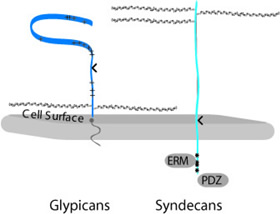
Ashok Srinivasan Eric Odom Charley Tharp Marina Lee Josh Dezeeuw
|
|
How do proteoglycans mediate early zebrafish development?
At the cell surface, the predominant heparan sulfate proteoglycans (HSPGs) belong to two families of core proteins: transmembrane syndecans and glycophosphatidylinositol-linked glypicans. We are investigating what role three syndecans and ten glypicans have during zebrafish development. Our initial results indicate that HSPGs are particularly required during gastrulation, an early developmental stage when the body plan is initially sculpted, and later in development during cardiovascular differentiation. Interestingly, all of these core proteins are expressed during gastrulation and have the same ubiquitous expression, yet functional analysis using either antisense oligonucleotides to reduce the expression of endogenous core proteins or overexpression of the full length core proteins suggests that most core proteins have a distinct function. We are also using genetic methods to identify zebrafish that have mutant HSPGs and developing tools to visualize the molecular interactions of HSPGs with cell-cell signaling molecules. We expect that the use of these complementary approaches will help us better define how the HSPGs function during zebrafish gastrulation and cardiovascular development.
|

Figure: Syndecans and glypicans are two families of HSPG core proteins that differ in the position of HS chain attachment, cysteines (+), protease cleavage sites (<), phosphorylation sites (*), and ability to directly bind cytoplasmic proteins (ERM, PDZ).
|